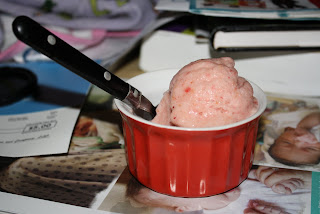First scoop of homemade sorbet was GOOD!
A lot of people in my neck of the woods find themselves buried in fruit come Summer time. Strawberries from March through the middle of June, peaches from late June through August and lemons as the weather cools off at the tail end of August. We are truly blessed to have such a bountiful supply of fresh produce and don't get me wrong, I appreciate not having to pay high prices for good food. But you can only can and pie so many fruits before your family (and friends) begin to look away when you enter the room (*whisper whisper* "She's bringing another cobbler!").
Fresh sorbet!
One thing at least my oldest son and I can agree on is that smoothies are good ANYTIME of the year, as many times a week as my blender can handle. Our favorite combo is 60-70% strawberries and 30% other fruit (and vegetable when I can sneak it past him). Even more so, we agree that sorbet is the bomb-diggity, especially when the clock ticks 9pm and it's still 95 degrees out. Finding myself with an abundance of swiftly-ripening peaches, I turned to the internet for a good recipe I could throw into my little blue ice cream maker and up popped this jewel. When I'm not fruiting it up, I'm an avid baker so I always have at least five pounds of sugar tucked away in my baking supply shop (the pantry) and if you like sorbet, so should you. Now all you need is ripe fruit and shazam! It's SORBET TIME!
Pretty flecks of REAL strawberry and peach amid ripe bananas
Lastly, the best fruit for any preparation is the kind that smells of what it is. I spend a lot of my time sniffing through the fruit section at my supermarket, huffing strawberry fumes and pineapple exhaust. If it don't smell good, it ain't gonna taste good neither!
Gotta have a little help when you make sorbet, donchaknaw?
~ The Recipe ~
Adapted from Curtis Aiken's Peach Sorbet found on Food Network (http://www.foodnetwork.com/recipes/curtis-aikens/peach-sorbet-recipe/index.html) because I only like to make what I'm going to use (even simple syrup).
Ingredients:
1 c roughly chopped strawberries, frozen*
1 c roughly chopped ripe peaches, frozen
1 large ripe banana, roughly chopped or broken into chunks
1 c sugar (or half a cup of Splenda)
1 c water
Splash of juice (I used orange, but whatever you've got on hand is good)
Place half of each fruit into jug of a blender. Bring water and sugar to a boil in a small saucepan; cook for about 5 minutes until all sugar is disolved and has thickened slightly. Pour hot syrup over frozen fruit, cover and blend until pureed. Add rest of fruit and splash of juice and blend until the consistency of a smoothie (add just enough juice to break down and loosen fruit). Scoop a bit off the top and try; should taste a little too sweet and won't run off spoon.** Freeze in ice cream maker according to manufacturer instructions (mine took about 10 minutes and actually got so thick the mixer stopped). Remove to air tight container and freeze for at least 1 hour or until scooping consistency.
* Freezing the fruit, instead of using fresh, helps this sorbet come together quickly, allowing for less time spent waiting for the final product. Eating is the objective here, isn't it? :-)
** Tastes buds become slightly desensitized when eating cold foods, so making your soft mix "too sweet" will give it a better mouth feel and flavor when you go to eat it.
Serving suggestions: Straight up, scooped into a pretty bowl with a spoon on the ready. Or if you're feeling breakfasty, try a sorbet mimosa: 1 champagne flute, your favorite bubbly and a scoop or two of this sorbet. This idea is making my mouth water! :-)
p.s. I've just enjoyed my first scoop and I've gotta say i really like it. It's like an uber thick smoothie; there's still quite a bit of texture because I didn't blend it down all the way (which I prefer). After about an hour and a half, the mix was still soft, so I took a fork and whipped it up a bit, to incorporate the frozen outer layer with the still gooey center. Will try a scoop in an hour or so and let you know how that goes.




 Set Aside
Set Aside